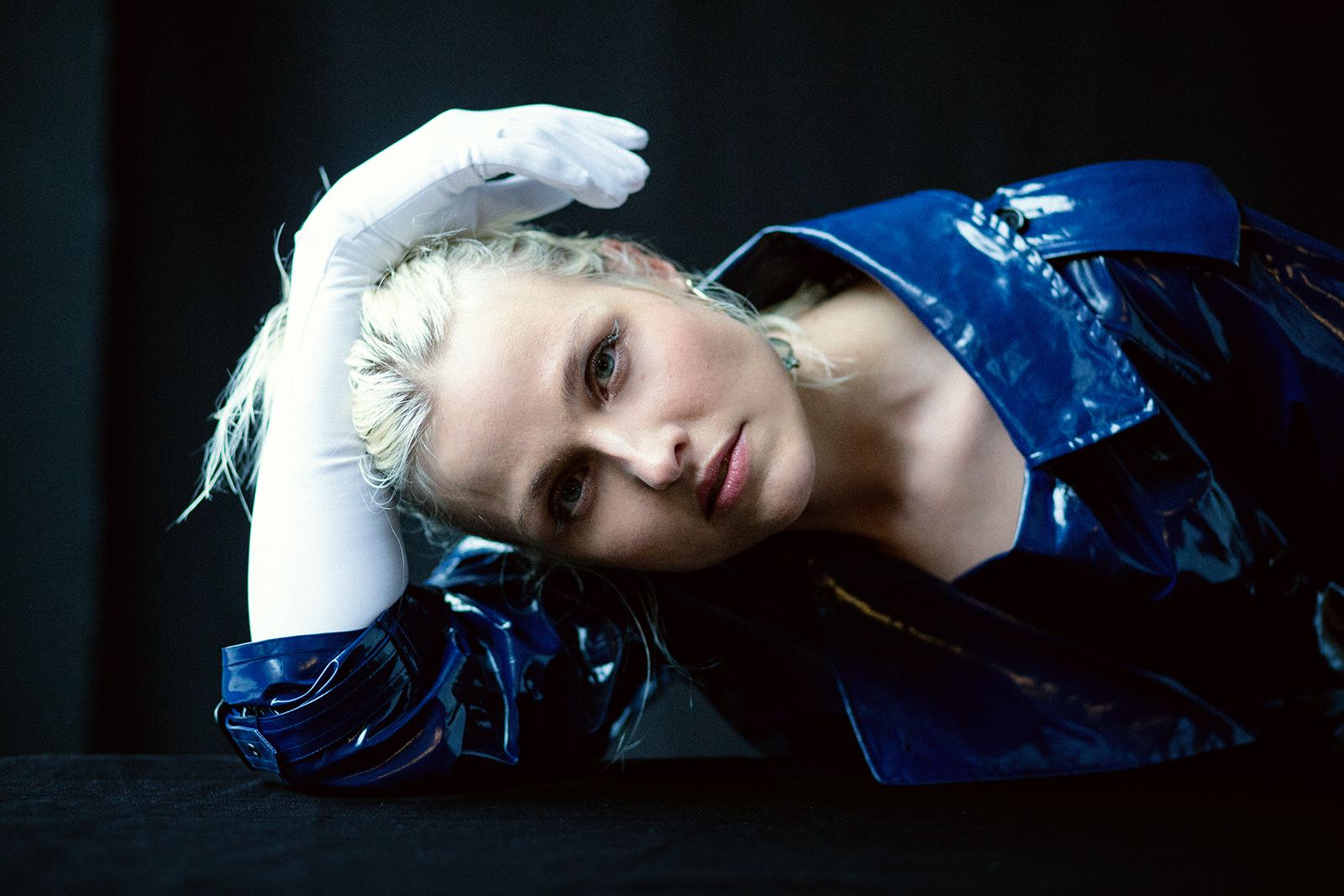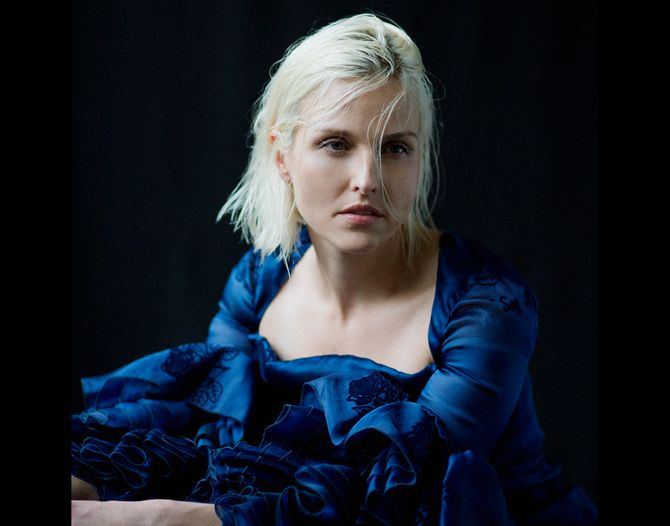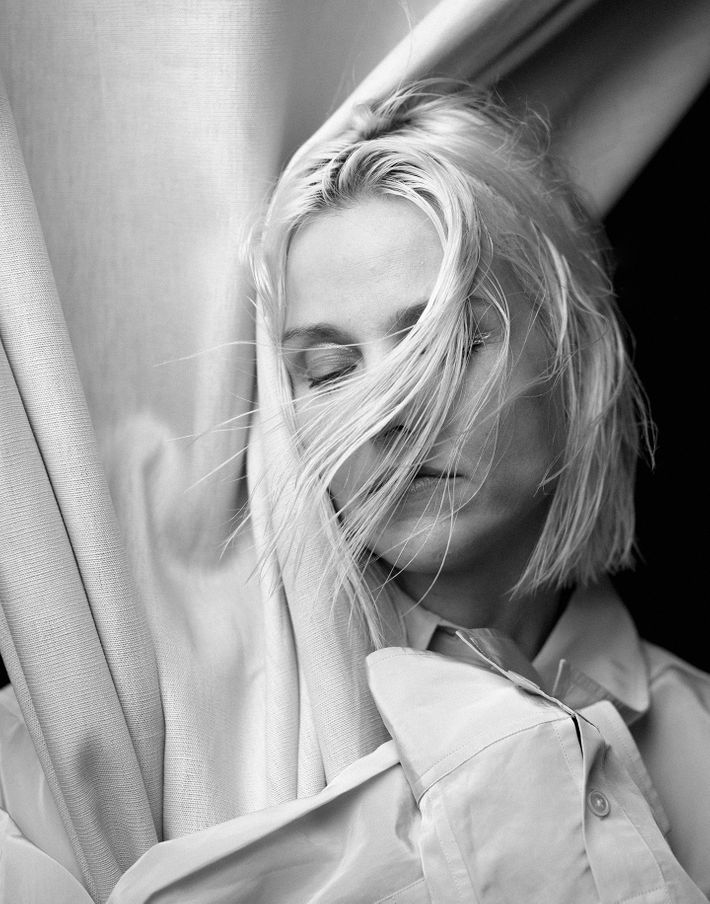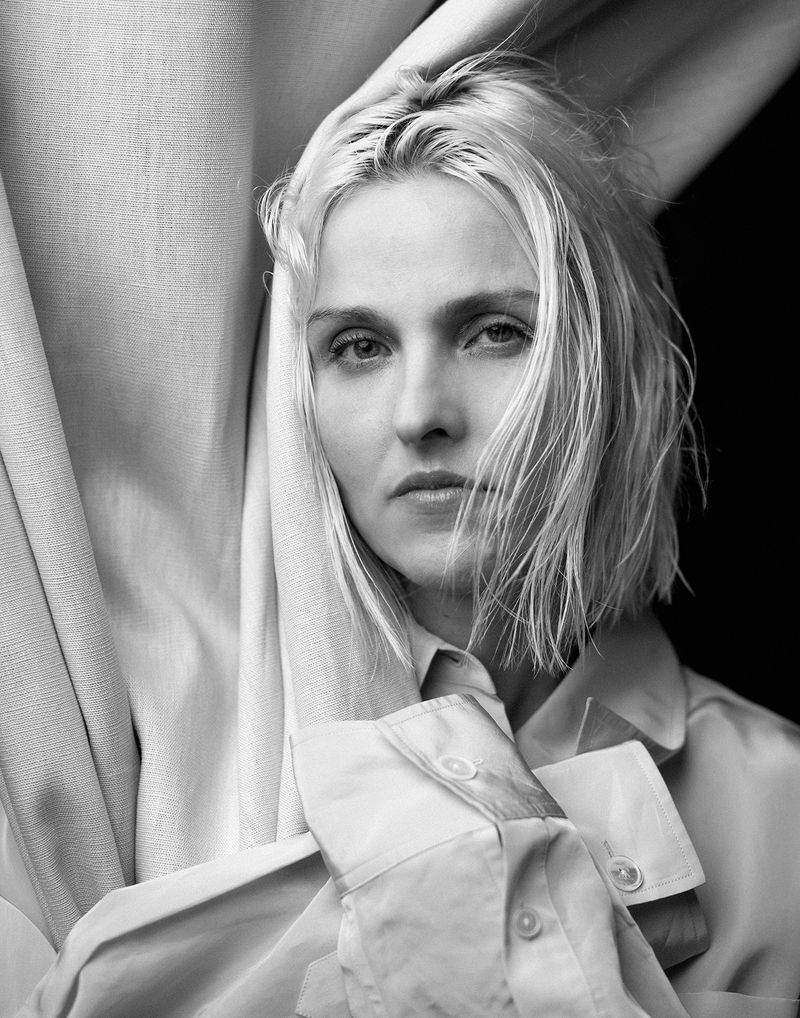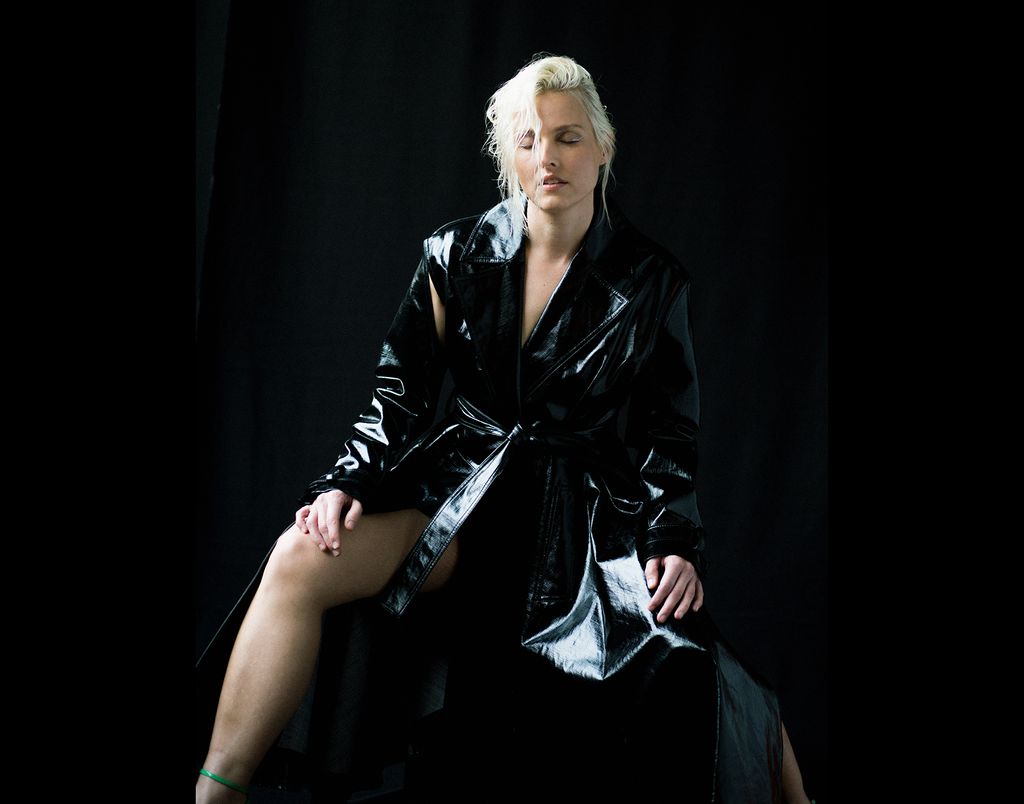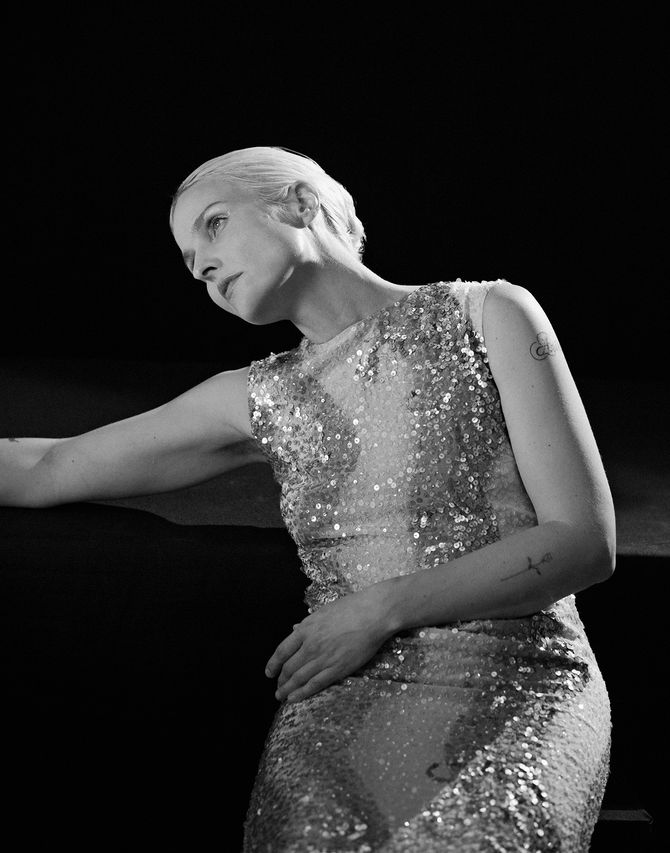Katja Blichfeld started 2017 with one tattoo, but after the two she’s getting today, she’ll end the year with eight. She’s standing outside the shop on Roebling Street, FaceTiming with her girlfriend as she waits for her appointment, and wearing a boxy quilted jacket, pale high-waisted jeans, and off-white leather shoes. Her white-blonde hair gleams in the sun. When we head inside, she takes off the jacket to reveal a black T-shirt printed with a photograph of Tupac and Marilyn Monroe.
Even though the shop has a rule that no one who’s not being tattooed is allowed past the reception area in front, Blichfeld convinces them to waive it for me. She does this without being a jerk but without being apologetic, either — she just listens to the explanation for the rule, making eye contact the whole time, then tells the artist why I need to hang out with her while she gets tattooed: “I’m being interviewed and this is the activity I said we’d do,” she says, un-self-consciously, like “being interviewed” and “doing an activity” are nothing to be ashamed of, which they’re not, but still. Blichfeld treats everyone she interacts with pretty much exactly the same, which is to say, she treats everyone with patience, curiosity, openness, and honesty, and then at the end of the interaction she gets exactly what she wants.
The artist ends up not only setting up a little stool for me near the tattoo chair, he also accedes to Blichfeld’s request that he do the rose tattoo she wants on her forearm in blue, not black, ink, even though he warns her many times that the color will bleed and fade. She doesn’t care. Tattoos are a corny and obvious way to announce an inner transformation, but like many corny and obvious things, they are also profound and effective. Since 2017 has changed Katja’s life forever — she began it at the end of her marriage to her most important collaborator, in mourning for losses both personal and national, and ended it in triumph, about to show the world the creative results of her new way of life — it makes sense to memorialize those changes in a tangible way. The rose ends up looking perfect, exactly how she’d envisioned it. The tattoo of her mother’s name in script on her deltoid ends up exactly how she wanted it, too.
The first time after coming out as gay that Katja saw her mom, her mom got teary. “It’s so amazing to see you be yourself, we feel like we have you back, it’s like a dark cloud has lifted,” she remembers her mother telling her.
This month, High Maintenance — the show that Blichfeld co-created with her ex-husband, Ben Sinclair — will begin airing its second season on HBO. Each episode centers on a different client buying weed from a dealer known only as the Guy, played by Sinclair. In the show’s earliest incarnation, as a DIY web series, episodes were a swift six, or eight, or 12 minutes; and like a lot of shows that got their start online around that time — Broad City, Be Here Nowish, The Misadventures of Awkward Black Girl — it combined scrappy urban verité with characters and points of view then considered too edgy for prime time. Some story lines were based on viral local news, like the 2009 Observer story about a girl dubbed the “Hipster Grifter.” This ripped-from-the-headlines quality, plus the show’s deft use of real NYC apartment interiors, sometimes gives it the feel of a utopian Law & Order, albeit one where a minor criminal, not cops or detectives, structures each episode of the show. And as the show has evolved — moving first to Vimeo and then to HBO — its intimate sense of detail has helped it maintain a devoted core of fans, who love it like the TV equivalent of a band they first saw playing church basements.
Before she was known for High Maintenance, Blichfeld was a casting director, a job at which she was very successful (she won an Emmy for her work on 30 Rock) and at which she arrived via an indirect path. Born in Long Beach, California, to Danish parents, she grew up attending Evangelical Christian schools, where she was taught that much of pop culture was the devil’s doing. “Like I couldn’t watch The Smurfs,” she explains, “because of witchcraft and sorcery.” She spent a couple of semesters at Long Beach City College, dropped out, moved to Chicago, worked in admin at a university, and then, in 2004, followed a relationship that had begun on Friendster to New York. “We were watching a lot of movies together, and the way that I would talk about movies was always very actor-centric. And I remember this person saying, ‘You should be a casting director.’” Blichfeld decided she’d try to get an internship. She made a list of people she wanted to work for, topped with Jennifer McNamara, who had just won a bunch of awards for her work on Sex and the City: “She, being a casting director — you know, very good at seeing potential — saw it in me, lucky me, and took me on.”
The ability to see potential — that semi-psychic way of assessing people at a glance — is a strength Katja shares. She jokes that it’s why she tends to date people who are younger than she is: “My best friends are all like, I think it’s just that you’re really turned on by possibility and potential.” She and Sinclair met at a party in L.A. when she was 30 and he was a struggling actor just a day shy of 25. “I just became very obsessed with this idea of us making something that would allow him to get decent footage for a reel,” she recalls. “And to get better opportunities and to show the side of him that I felt like maybe the casting directors were missing.” It also gave her a chance to tap the unused potential she encountered in her day job at 30 Rock — all the talent she saw but couldn’t cast. She and Sinclair began writing together almost immediately after becoming a couple, and up through the first season of High Maintenance on HBO they remained the show’s sole writers.
In the final episode of that season, audiences got a rare glimpse of the Guy’s life off-duty: We see that he lives down the hall from his ex-wife, who has left him for another woman. Blichfeld and Sinclair wrote the episode before their own split, and before she experienced the life-altering revelation that she was gay. Though she’d dated women for years, something — her Evangelical Christian education, her own internalized homophobia — had held her back from admitting the full reality of her sexual orientation. But though she says it had been coming for a long time, Donald Trump’s election is what forced the breakthrough — she and Sinclair decided their relationship was over for good on election night. Blichfeld calls it the “punctuation” on that period of uncertainty and suffering. Sinclair, though upset, was not surprised. (“I mean, he went to Oberlin,” she says.)
While the divorce has been painful, none of Blichfeld’s friends or family members were shocked, either. Even her parents, who are no longer religious, have been supportive. Katja — joking, but also not — describes the breakup as a true “conscious uncoupling.” After splitting up, they spent the next seven months working 70-hour weeks at each others’ sides, which Sinclair calls “exposure therapy.” They share a manager and an assistant. Sinclair still lives in the apartment the couple shared; Blichfeld moved out, and, at the moment, her girlfriend is living with her while between apartments. A writer named Adele, she met Katja when Katja was on a date with someone else and — her eye for potential sharp as ever — Adele was her server.
My own interest in Blichfeld ascended to full-on fascination when I started following her on Instagram. She documents her life there with the same detail-oriented directorial skill she brings to the show, and her Stories have painted the picture of a woman in the midst of a profound and joyous, but not uncomplicated, year of awakening. She’s blasé about the medium — she says she feels self-conscious and hates that she keeps track of what gets more likes — but she must know that her account is engrossing.
A big part of it is the visual appeal of her uniquely androgynous and original personal style. Most of her wardrobe is thrifted. In 2018, anyone can look cool with enough money and effort, and some of High Maintenance’s best moments occur when it deftly undermines people whose style doesn’t match their substance. But Katja is cool — she could take any item off any rack at Buffalo Exchange, put it on, and you’d think, Yes. I need that. Sinclair told me that he remembers meeting Blichfeld with almost-photographic precision: The long blue patterned halter-top dress she was wearing at that party and the worn-thin T-shirt with a black-and-white bra underneath she wore to his 25th birthday are still emblazoned in his memory.
Lately her style has become even more experimental and vibrant: She says she used to wear mostly black, and now she avoids it. “I’m such a cliché; now I’m gay, I’m wearing bright colors,” she laughs. At our first meeting she wore a peacock-blue hoodie under a diaphanous silvery-white Rachel Comey top (from a sample sale — the designer is a friend, as viewers of the episode “Rachel” may have guessed), Adidas-style track pants, hiking boots, and a perfectly oversize black wool coat.
Since coming out, she’s also smoking less weed. Thanks to her early anti-drug programming, Blichfeld came to weed late, in her mid-20s, but then made up for lost time: As she dealt with anxiety and depression, she started a regular habit that soon included waking up and getting high, gaining such a high tolerance that she had to smoke what now seems to her to be mind-boggling amounts. “I didn’t want to feel my feelings all the time,” she says. “And now I feel much more accepting and okay with feelings, even if they’re not great.” She emphasizes, however, that she does still smoke — and it’s obvious that stoner culture will always be in the show’s DNA.
In this season’s premiere, the camera dips into the point of view of a man walking past a restaurant, then eavesdrops on the conversations at several tables, before following the path of a plate of tainted mussels back into the kitchen, where we finally encounter the character who, after several false starts, will be this episode’s protagonist (insofar as it has one). Something High Maintenance shares with the experience of being high is an easy willingness to pay attention to stuff that might not otherwise interest you — to follow unexpected associations and trains of thought farther than you ordinarily would. Meanwhile, the episode also alludes to, but doesn’t exactly mention, Trump’s election. It quickly becomes clear that some unnamed horrible thing has happened, and the city is dealing in varied ways: brunching and bingeing, getting blackout drunk, having a threesome with strangers, working like it’s a normal day because your family depends on you.
It’s the first episode to air since High Maintenance gained a writers room beyond just Blichfeld and Sinclair. Their breakup precipitated a huge shift in the way they wrote the show. Up until then, they’d collaborated exclusively on every episode — a rare if not completely anomalous way to make a premium cable show — and they went about hiring writers in an unconventional way, too. By reading submissions blind, they assembled a group of people who look like the show, which has always been notably queer and female (even if it nominally revolves around the Guy). Before, Blichfeld and Sinclair would take turns writing the bulk of each episode solo depending on who felt closer to the story, sometimes improvising dialogue back and forth but more often just taking turns. Now, Blichfeld says, she can’t believe they didn’t always have a writers room: “It’s just so much more fun to collaborate.” The writers she and Sinclair chose were diverse in their writing backgrounds, too, from short-story writers to playwrights. (Sinclair says that having the room also helped them work past the trauma of their split: He remembers laughing for the first time after the breakup, six weeks on, because someone in the room remarked that it was the first time they’d ever seen him laugh.)
The result is an even better, richer version of the show. If the theme that ran through the last season was confinement, this season seems to be about escape, with all its attendant thrills and responsibilities. The Guy also becomes more of a fleshed-out character; one episode focuses almost exclusively on his relationship with his ex-wife as she cares for him after a bike accident. Some of the episodes — like one about a couple who moves from a communal loft to a subsidized apartment in a sleek new condo — activated my class consciousness in a way that had me cringing, but the cringe was never the revolted, complicit cringe that I get watching Girls or Curb Your Enthusiasm. When the show was a web series, episodes had less room for multi-dimensionality, but now the show can really flex its empathy: Even when the characters are assholes, they’re never caricatures, and they’re rarely unredeemable. Watching the new episodes alongside the old ones reveals both contrast and continuity.
Blichfeld’s close friend and manager Russell Gregory describes what she brings to the High Maintenance set as subtle, ineffable, and completely necessary to the show’s authenticity. “She’ll be the only one who’ll notice an extra’s socks and say ‘They’re wrong for this neighborhood,’” he says. “We’ll think that’s crazy, and then in the playback we’ll be like ‘The socks are wrong.’” With Katja, “There’s just a thing that everybody does, we kind of look to her to see if she’s smiling, or if her eyebrows are up, or if she’s attentive, or if she’s not really into it. You kind of try and read how she feels to gauge how to move forward.”
I see the same thing when we’re eating lunch a few weeks pre–tattoo date at Marlow and Sons, a restaurant where she knows everyone, of course. There’s a subtle way she wields control that makes everything about the situation perfect. She would never, ever be so gauche as to gesture for a waitress’s attention or seem impatient, but she gets exactly what she wants — hot water with lemon, our plates cleared — with zero agita. If there was ever a version of Katja who worried about the impression she was making, 2017 has definitely eliminated the last traces of her.
“That anxiety I used to, like, wake up every morning, truly for my whole life, this sense of something going wrong, this sense of dread and doom” — that, she says, has been suddenly, miraculously erased. It’s wonderful, but also confusing. What does she do with her memories, for example — what about her marriage, the whole story of her love for Sinclair and how it created the project that’s still defining her life? “Was everything that I’d done to that point a lie? What does it do to my narrative?”
This season is designed to end in a way that would be a satisfying series finale, if need be — getting picked up again is always a crapshoot. And though she’d love to see the show continue, she’s also eager to work on the projects that she’s starting to write, for the first time, without Sinclair. One of the other tattoos she got this year is of the words “Best Crab,” an inside joke with Gregory. According to him, it’s about how she wants “to nurture and grow people,” sometimes at her own expense — like the character in Joy Luck Club who takes the worst crab for herself, rather than reaching for the best one. The tattoo is a reminder to reach for the best, and for the potential in herself that she’s only recently begun to realize.
